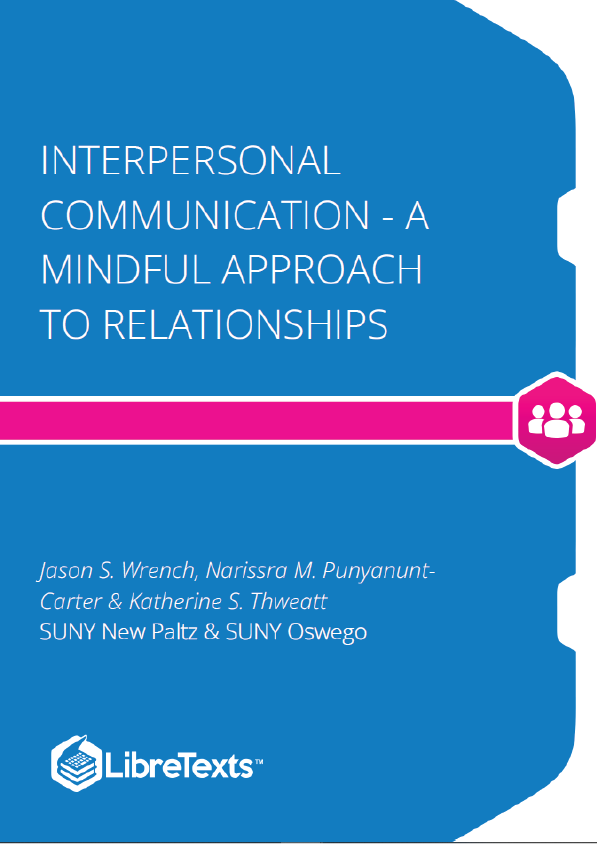Interpersonal Communication: A Mindful Approach to Relationships helps readers examine their own one-on-one communicative interactions using a mindfulness lens. The writing team of Jason S. Wrench, Narissra M. Punyanunt-Carter, and Katherine Thweatt incorporates the latest communication theory and research to help students navigate everyday interpersonal interactions. The 14 chapters in this book cover topics typically taught in an undergraduate interpersonal communication course: family interactions, interpersonal dynamics, language, listening, nonverbal communication, and romantic relationships, as well as exploring emerging areas such as self-compassion, body positivity, friendships, and “the dark side”. The writing takes on a purposefully informal tone to engage readers. Each chapter is broken into different sections that have unique instructional outcomes, key takeaways, and exercises, and concludes with real-world case studies and sample quiz questions.
Relationships
The first major statistical concept that anyone studying the social sciences must understand is statistical relationships. We don’t want to get too technical in our discussion of relationships, but we do want to explain some of the basic ideas. When we examine relationships, we must have scores on two different variables for a single person. Now the word “variable” simply refers to anything that can vary from person-to-person: for example, your height, weight, public speaking anxiety, best friend relationship satisfaction, etc. There are thousands of possible variables that social scientists studying interpersonal communication can examine. However, we generally don’t examine a single variable in isolation. We’re more likely to examine two or more variables.
To help us examine the idea of relationships, we’re going to use an article from Melissa Wanzer and Melanie Booth-Butterfield that examine someone’s “humor orientation.”3 The variable “humor orientation” is measured by a survey, which you can learn more about on Steven Booth-Butterfield’s website. Humor orientation is the use of jokes and joking during interactions with other people. In this study, the researchers had Person 1 complete the Humor Orientation (HO) Scale (self-reported HO) and had Person 2 complete the HO about Person 1 (other-reported HO).
Positive
One of the first significant findings in this study was a positive relationship between someone’s perception of another person’s humor orientation (other-reported HO) and their popularity (social attractiveness). The term “positive relationship” here simply means that as someone’s score on the HO measure went up (people were seen as using more jokes and joking during their interactions with others), the more popular they were viewed by other people. In a positive relationship, the opposite is also true. People who were not viewed as using jokes and joking during their interactions were viewed as less popular by others. In essence, in a positive relationship as scores on one measure go up, the scores on the other measure go up. As scores on one measure go down, then scores on the other measure go down.
Negative
The second type of relationship we find using statistics is called a negative relationship. A negative relationship occurs when scores on one variable go up and scores on the second variable go down. In the Wanzer and Booth-Butterfield study, the researchers found that people who viewed themselves as having a strong humor orientation (higher scores on the HO scale) reported lower levels of loneliness. As scores for someone’s HO went up, then scores for reported loneliness went down. Again, the opposite is also true. As someone’s HO went down, their scores for reported loneliness went up.











